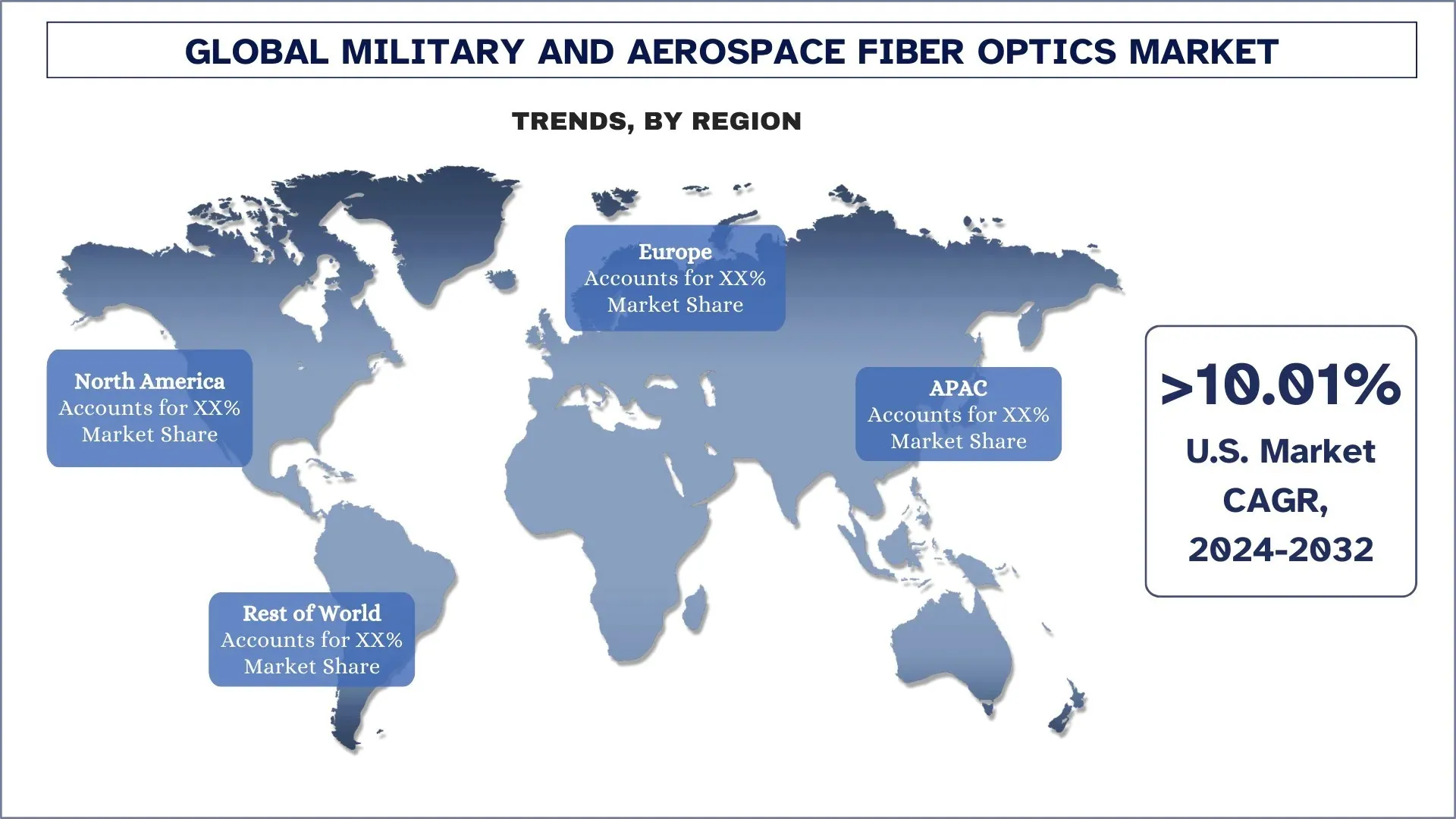Military and Aerospace Fiber Optics Market: Current Analysis and Forecast (2024-2032)
Emphasis on Type (Single-Mode and Multi-Mode); Application (Communication Systems, Avionics, Weapon Systems, Surveillance and Reconnaissance, Electronic Warfare, and Others); End User (Commercial, Military, Space, and Others); and Region/Country

Military and Aerospace Fiber Optics Market Size & Forecast
The military and aerospace fiber optics market was valued at approximately USD 3.08 billion in 2023 and is expected to grow at a substantial CAGR of around 9.54% during the forecast period (2024-2032) owing to the demand for network-centric warfare and the advancement in fiber technology drive market growth.
Military and Aerospace Fiber Optics Market Analysis
In defense and aerospace, the term military fiber optic products and technologies refers to the advanced optical fiber technology used for high-speed data transmission, communication, sensing, and navigation in defense and aerospace. High speed, low latency, electromagnetic interference immunity, and lightweight constitute the improved performance attributed to these systems, thereby making them critical applications in aircraft, satellites, missiles, and battlefield communication systems. Increased defense budgets, military infrastructure modernization, and the emergence of unmanned systems drive the market. Network-centric warfare and the requirement for real-time data transmission in theater operations are some of the contributing factors to the demand. Moreover, the aerospace domain is increasingly taking onboard fiber optics for their future aircraft and satellites to enhance performance and reduce weight while meeting sustainability goals. Advancements in fiber optic technology such as multi-core fibers and photonic integrated circuits along with increased investment in space exploration and defense modernization programs worldwide are expected to expand the global market further by 2032. This makes it evident that fiber optics will increasingly become a means to satisfy future requirements in military and aerospace applications.
Military and Aerospace Fiber Optics Market Trends
This section discusses the key market trends influencing the various segments of the military and aerospace fiber optics market as identified by our research experts.
Integration of Photonic Integrated Circuits (PICs)
The advancement of photonic integrated circuits is a paradigm shift in fiber optics by miniaturizing optical components and improving performance levels. The PICs also find incorporation into military communications and avionics as well as electronic warfare platforms in delivering high data rates, lesser power consumption, and increased reliability.
For instance, the AN/ALQ-99 Tactical Jamming System used by the Navy of the United States has had PIC-based fiber optic modules that were enhanced to become more sophisticated in their electronic warfare capabilities, ensuring secure and interference-free communication.
Military and Aerospace Fiber Optics Industry Segmentation
This section provides an analysis of the key trends in each segment of the global military and aerospace fiber optics market report, along with forecasts at the global, regional, and country levels for 2024-2032.
The single-mode fiber optics market dominates the military and aerospace fiber optics market
Based on type, the military and aerospace fiber optics market are segmented into Single-Mode and Multi-Mode. In 2023, the single-mode fiber optics market dominated and is expected to maintain its leading position throughout the forecast period. Due to superior performance in long-distance telecommunications, bandwidth capabilities, and attenuation of the signal strength, single-mode fiber optics are preferred over multi-mode fibers. Characteristics preferred for military and aerospace applications, where reliability, precision, and long-range data transmission are important. Single-mode fibers are favored due to their ability to transmit data over long distances with minimal signal loss. Thus, they are the most suitable for critical military and aerospace applications where reliability and performance of communication are paramount. Single-mode fibers are built with a small core that gives room for only one mode of light to travel through it, thus greatly minimizing the chances for data to degrade for long-distance transmission compared to multi-mode fibers. Single-mode fibers have been further favored because of the increasing need for high-bandwidth, long-reach communications in military and aerospace operations. These fibers allow high-speed data transfer necessary for advanced applications such as surveillance, radar systems, and secure communication lines employed in military operations. Single-mode fibers also become a cost-effective solution for large networks because of their attribute of low signal loss over long distances.
The communication systems market segment dominates the military and aerospace fiber optics market
Based on application, the military and aerospace fiber optics market is segmented into Communication Systems, Avionics, Weapon Systems, Surveillance and Reconnaissance, Electronic Warfare, and Others. The communication systems segment continues to dominate the military and aerospace fiber optics market due to its critical role in ensuring secure, high-speed, and reliable data transmission across modern defense and aerospace platforms. The increased reliance on these unmanned systems, including drones and UAVs, with the growing tendency toward network-centric warfare, has made the demand for next-generation fiber-optic communication systems rise. The backbone, for instance, relies on fiber optics for having the communications infrastructure on the F-35 Lightning II fighter jet, which relays continuous data link exchange between onboard avionics systems, sensors, and command centers. In the same way, in satellite communication systems, fiber optics ensure high-bandwidth and low-latency data transfer needed to conduct military operations and gathering of intelligence on a worldwide scale. The adoption of fiber optics is also supported by the rise of electronic warfare (EW) which requires secure communication networks in contested environments. Unlike conventional copper cables, fiber optics offer a means of communication that is practically non-interceptable and jam-proof, thereby making them a good candidate for providing secure military communications. Heavy investments in the development of fiber optic networks by the U.S. Department of Defense have been made to enhance the resilience and security of its global communication infrastructure.

North America dominated the Global Military and Aerospace Fiber Optics Market
The North American region remains the largest market for military and aerospace fiber optics due to several factors such as the advanced defense industry, substantial military budget, and increasing adoption of autonomous weaponry. Fiber-optic technology has inherent advantages in the defense sector due to a well-established technological infrastructure and continuous innovation sustained in North America. Some of the largest defense manufacturers in the world, Lockheed Martin, Raytheon, and Northrop Grumman are investing in fiber optics heavily into integrating it into their military and aerospace programs. These companies depend on fiber optics for applications like high-speed data transmission, secure communication, and real-time monitoring systems of great significance. Additionally, next-generation technologies in the defense sector such as hypersonic weapons, advanced fighter jets, and cyber-defense systems, all of which are dependent on fiber optics that support enhancement-low signal loss and immunity to electromagnetic interference, thus providing for valid communication inside that are secure and high-performance in nature. This communication is required to make and maintain operational efficiency in modern warfare. The growing demand for fiber optics due to the imminent proliferation of autonomous weapon systems and UAVs as part of military operations has further propelled the market growth. Furthermore, the continued setting up of 5G and communication infrastructure in its military environments and, the adoption of fiber supported an important fast-track avenue for data transmission with security characteristics equally applicable to civil-aerospace use has secured the market growth positively.

Military and Aerospace Fiber Optics Industry Competitive Landscape
The military and aerospace fiber optics market is competitive, with several global and international players. The key players are adopting different growth strategies to enhance their market presence, such as partnerships, agreements, collaborations, geographical expansions, and mergers and acquisitions.
Top Military and Aerospace Fiber Optics Manufacturing Companies
Some of the major players operating in the market are Amphenol Aerospace, Prysmian Group, Collins Aerospace, AFL, Nexans, Optical Cable Corporation, W. L. Gore & Associates, Inc., Corning Incorporated, TE Connectivity, and Timbercon, Inc.
Recent Developments in the Military and Aerospace Fiber Optics Market
- In March 2024 – AFL announced million-dollar investments, exceeding USD 50 million, to expand its fiber optic cable manufacturing operation in South Carolina. Such an initiative is expected to be funded under the U.S. government's Infrastructure Investment and Jobs Act and the Internet for All programs to bring broadband access to every corner of the country. This extension is likely to create an array of new jobs, boost local economies, and ensure that AFL products comply with the Build America, Buy America Act (BABA). This investment is in addition to AFL's earlier commitment of more than USD 35 million to manufacturing cables within the United States. Such investment focuses on promoting broadband deployment and modernization of power grids.
- In January 2023 – AFL, the foremost manufacturer of fiber optic cable and fusion splicing equipment, unveiled a new generation of fusion splicing and fiber preparation equipment during the recently concluded SPIE BiOS and Photonics West exhibitions. Included in the new line are advanced recoaters and cleavers among other equipment designed to enhance fiber preparation and protection for fusion splicing. This new product line is developed to meet the highly technical needs of specialty optical fibers. Such high-performance tools are expected to improve reliability and reproducibility and, thus, provide users with greater confidence in fiber optic operations.
- In April 2023 – SEDI-ATI, one of the major manufacturers of fiber optics for the military and aerospace sector launched the fiber optic for optopyrotechnic trains, from coupling the laser into the optical fiber to checking the line's integrity.
Military and Aerospace Fiber Optics Market Report Coverage
Report Attribute | Details |
Base year | 2023 |
Forecast period | 2024-2032 |
Growth momentum | Accelerate at a CAGR of 9.54% |
Market size 2023 | USD 3.08 billion |
Regional analysis | North America, Europe, Asia-Pacific, Rest of the World |
Major contributing region | The Asia-Pacific region is expected to grow at the highest CAGR during the forecasted period. |
Key countries covered | U.S., Canada, Germany, France, UK, Spain, Italy, China, Japan, and India |
Amphenol Aerospace, Prysmian Group, Collins Aerospace, AFL, Nexans, Optical Cable Corporation, W. L. Gore & Associates, Inc., Corning Incorporated, TE Connectivity, and Timbercon, Inc. | |
Report Scope | Market Trends, Drivers, and Restraints; Revenue Estimation and Forecast; Segmentation Analysis; Demand and Supply Side Analysis; Competitive Landscape; Company Profiling |
Segments Covered | By Type, By Application, By End User, and By Region/Country |
Reasons to buy military and aerospace fiber optics market report:
- The military and aerospace fiber optics market analysis includes market sizing and forecasting analysis validated by authenticated key industry experts.
- The report presents a quick review of overall industry performance at one glance.
- The report covers an in-depth analysis of prominent industry peers with a primary focus on key business financials, product portfolios, expansion strategies, and recent developments.
- Detailed examination of drivers, restraints, key trends, and opportunities prevailing in the industry.
- The study comprehensively covers the market across different segments.
- Deep dive regional level analysis of the industry.
Customization Options:
The global military and aerospace fiber optics market can be customized further as per the requirement or any other market segment. Besides this, UnivDatos understands that you may have your own business needs, hence feel free to connect with us to get a report that completely suits your requirements.
Table of Contents
Research Methodology for Military and Aerospace Fiber Optics Market Analysis (2022-2032)
We analyzed the historical market, estimated the current market, and forecasted the future market of the global military and aerospace fiber optics market to assess its application in major regions worldwide. We conducted exhaustive secondary research to gather historical market data and estimate the current market size. To validate these insights, we carefully reviewed numerous findings and assumptions. Additionally, we conducted in-depth primary interviews with industry experts across the military and aerospace fiber optics value chain. After validating market figures through these interviews, we used both top-down and bottom-up approaches to forecast the overall market size. We then employed market breakdown and data triangulation methods to estimate and analyze the market size of industry segments and sub-segments.
Market Engineering
We employed the data triangulation technique to finalize the overall market estimation and derive precise statistical numbers for each segment and sub-segment of the global military and aerospace fiber optics market. We split the data into several segments and sub-segments by analyzing various parameters and trends, including type, application, end user, and regions within the global military and aerospace fiber optics market.
The main objective of the Global Military and Aerospace Fiber Optics Market Study
The study identifies current and future trends in the global military and aerospace fiber optics market, providing strategic insights for investors. It highlights regional market attractiveness, enabling industry participants to tap into untapped markets and gain a first-mover advantage. Other quantitative goals of the studies include:
Market Size Analysis: Assess the current and forecast market size of the global military and aerospace fiber optics market and its segments in terms of value (USD).
Military and Aerospace Fiber Optics Market Segmentation: Segments in the study include areas of type, application, end-users, and regions.
Regulatory Framework & Value Chain Analysis: Examine the regulatory framework, value chain, customer behavior, and competitive landscape of the military and aerospace fiber optics industry.
Regional Analysis: Conduct detailed regional analysis for key areas such as Asia Pacific, Europe, North America, and the Rest of the World.
Company Profiles & Growth Strategies: Company profiles of the military and aerospace fiber optics market and the growth strategies adopted by the market players to sustain the fast-growing market.
Frequently Asked Questions FAQs
Q1: What is the military and aerospace fiber optics market's current size and growth potential?
The military and aerospace fiber optics market was valued at USD 3.08 billion in 2023 and is expected to grow at a CAGR of 3.5% during the forecast period (2024-2032).
Q2: What are the driving factors for the growth of the military and aerospace fiber optics market?
The primary market drivers for the military and aerospace fiber optics market include the growing demand for network-centric warfare and the advancement in fiber technology drive market growth.
Q3: In the type category, which segment has the largest market share of the military and aerospace fiber optics market?
The single-mode fiber optics market has the largest market share of the military and aerospace fiber optics market.
Q4: What are the major trends in the military and aerospace fiber optics market?
The Integration of Photonic Integrated Circuits (PICs) and the Adoption of Multi-Core Fibers are the major trends in the military and aerospace fiber optics market.
Q5: Which region will dominate the military and aerospace fiber optics market?
The North America region dominated the market in 2023.
Related Reports
Customers who bought this item also bought










